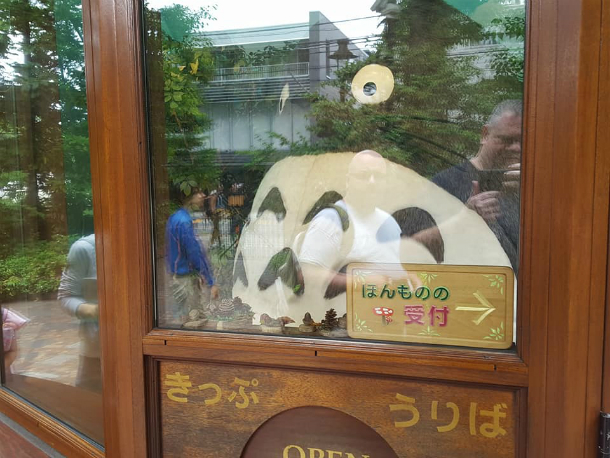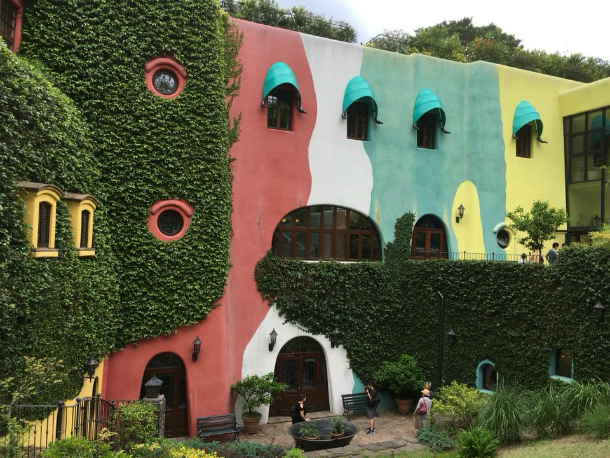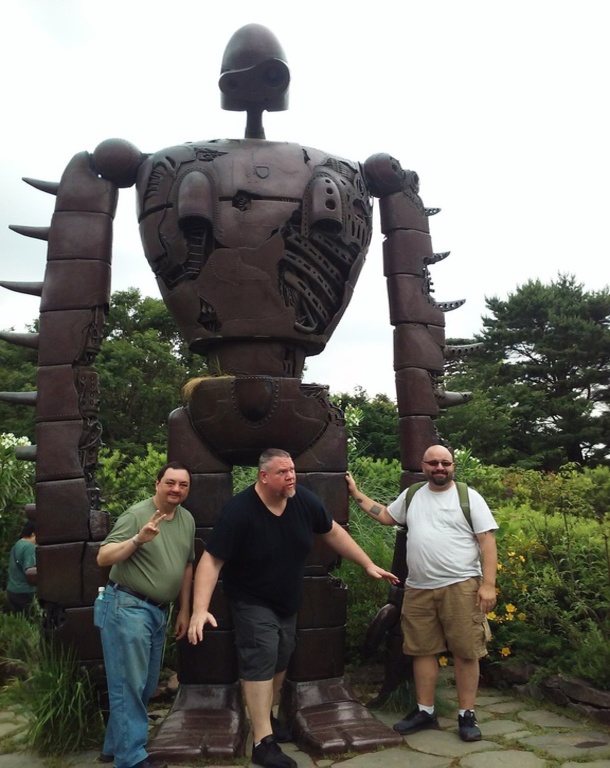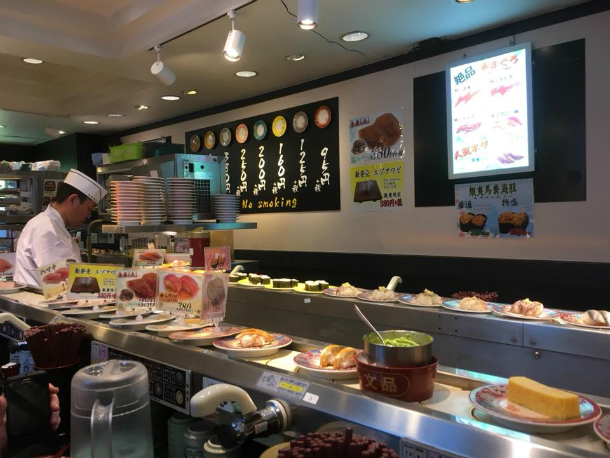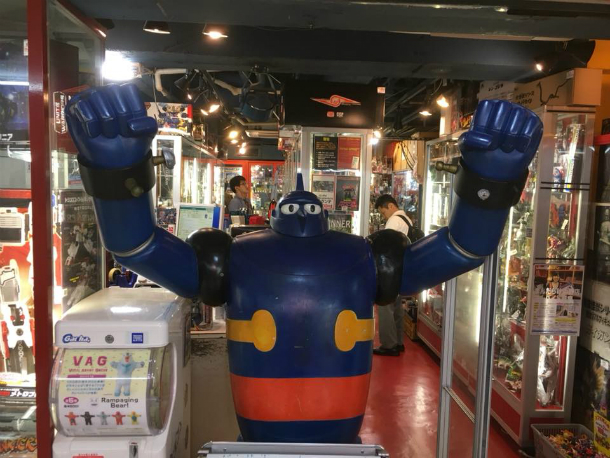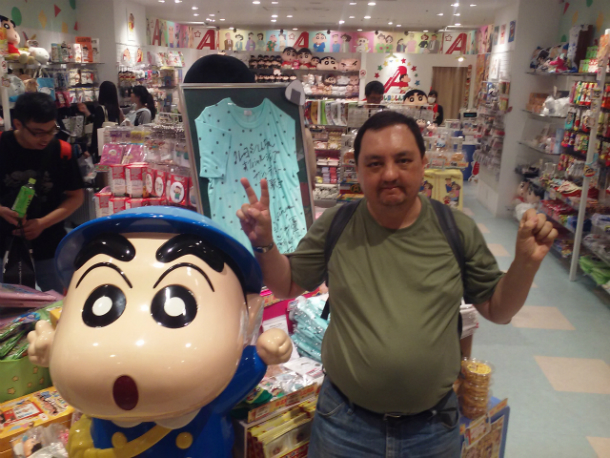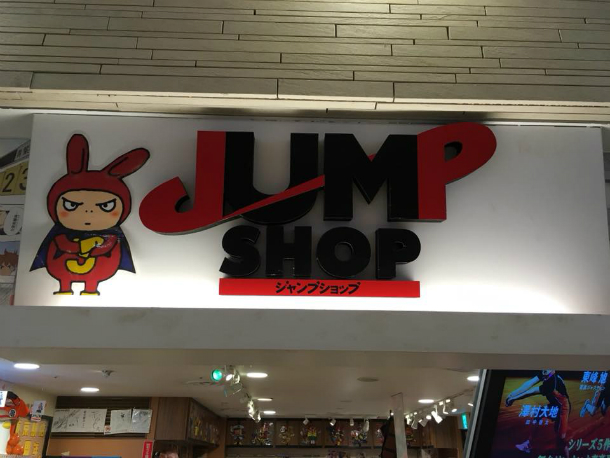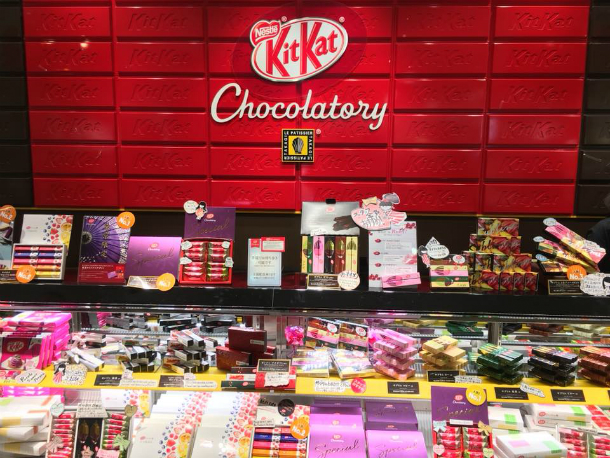Tokyo Vacation May 2018 Day 6
After getting back to the hotel room late after the movie and composing the blog record of the day’s events, I didn’t get to sleep until 5am. So I was quite tired when I woke at nine. While Scott went to exercise in the hotel exercise room, Justin & I went downstairs for the breakfast buffet. Then we all met in the room and left the hotel together at 10:45. After arriving at Shinjuku Station via the hotel shuttle bus, we took the Chuo Rapid line to Mitaka. The Mitaka station is moderately sized and contains a number of attractive restaurants. We exited the station, took an escalator down to the ground floor, then began searching for the canopy signifying the pick-up point for the Ghibli Museum. A considerate local woman speaking relatively confident English directed us to go back the way we’d come until we saw the canopy and the machine selling tickets for a ride to the museum.
At the automated machine, each of us paid the 360 yen fee for a round-trip ride to and from the museum. Then we waited a few short minutes until the bus began loading. The guide directing the bus embarkation from the sidewalk encouraged us to separate our single perforated bus ticket into “to” and “from” tickets before boarding. We boarded the Mitaka City bus, which was painted in white and yellow with the images and name of the Ghibli Museum on its exterior, dropping our paper tickets into a small plastic box beside the driver.
The bus wound through dense residential areas and for quite a while followed alongside a stream separating city from dense forest. After several stops, the bus pulled parallel to the Inokashira Park. When we exited the bus and walked the several yards back toward the museum’s entrance, a lengthy line of the day’s guests was already waiting. The line stretched from the ticketing house back to the exterior restrooms and a canopy tent, around the side of the building, all the way back to the life-sized O-Totoro inside a replica ticket booth. Thankfully, the line moved quickly. A pair of employees compared patrons’ legal identification cards against the names on the museum tickets. Our tickets were scheduled for a noon entry. We arrived in the line nearly 15 minutes early.
When we entered the museum, we first queued for the short movie screening. The museum was screening Miyazaki’s Kemushi no Boro short film. The beautifully animated short has no soundtrack. Rather, all of its sound consists of manga-style sound effects and reaction sounds like “zawawawa” and “dondondondon” and “shuu shuu shuu shuu” contributed by comedian Tamori. The short film is adorable, of course, and like all good family anime, doesn’t avoid depicting both the wondrous and the crude or harshly amoral aspects of the natural life cycle. After we toured the first floor of the museum, Justin opted to climb the museum’s indoor spiral staircase. Scott and I moved to meet him on the second floor but then realized that the spiral staircase expired at the third floor. Scott & I found Justin in the Kemushi no Boro exhibit. The “Boro” gallery stretched down one hall. The sides of the hall housed samples of storyboards & animation frames from the short film’s production. The hallway itself was adorned with standees of “Boro” characters. Then we made our way through the regular second floor exhibition on the work of Ghibli’s animators. The exhibit rooms featured idealized recreations of Hayao Miyazaki’s work environments, and walls covered in storyboard images, genga, and final production artwork.
Scott suggested that we check out the museum’s rooftop. We walked out onto the porch through a doorway next to the giant plush catbus that small Japanese children were climbing on. The outdoor porch housed a pair of steel “leaf skeleton” benches, a sort of clockwork water fountain, and an enclosed spiral staircase leading to the topmost roof. We took a photo for a small group of American schoolgirl tourists. Then we climbed the external staircase to the rooftop and found a life-sized statue of the broken down Laputa guardian robot. Museum guests stood in a patient line for opportunities to pose before the robot statue for photographs. Since we’d taken a snapshot for the five young women, they returned the favor for us.
We briefly climbed down to the museum’s ground floor interior courtyard.
We returned to the museum’s second floor and turned into the “Taberu wo Kaku” (“Drawing Eating”) exhibit. The exhibit amply demonstrates the extent of the staggering effort Ghibli animators have devoted to drawing Ghibli’s films. The exhibit also included three-dimensional replicas of the foods prominently depicted within Ghibli films. At the sample recreation of the outhouse kitchen from Tonari no Totoro, patrons removed their shoes in order to walk over the tatami floor of the interactive set. The set was followed by a similar replica of the kitchen of Dola’s airship that museum patrons walked through, complete with cabinets fully stocked with cups and plates, preserved spices, and large cheese wheels.
In the museum’s gift shop, Justin & Scott each selected a small, plush caterpillar “Boro” keychain. Justin also purchased an inexpensive charm replica of Sheeta’s levitation stone. I also found a small Boro doll that would shiver and wiggle when its drawstring was pulled. I gave Justin 1,000 yen to purchase it for me at its 972-yen price while I walked to the other side of the fourth floor to patronize the book store. I was relieved to find that the ten Ghibli Museum exclusive movie programs cost 400 yen each rather than the 1,000 yen each I feared they’d cost. So I purchased all ten short film memorial books plus a booklet devoted to the “Taberu wo Kaku” exhibit for 5,100 yen. I’m rather certain that I already own two of the short film program books for the movies I’ve previously seen, but I chose to purchase a set rather than risk not having them all.
We then exited the museum’s grounds and returned to the bus stop, eventually climbing aboard the city bus and riding until the bus circled back around to the Mitaka station. At the station, we boarded the Chuo-Rapid again and stayed on it until it reached Nakano. The overcast sky had begun to rain consistently but lightly. We stopped to investigate Tenma Curry in the Nakano Sun Mall. After being seated, Justin & I each ordered a 500-yen fried curry & cheese bun & cup of homemade ginger ale meal set. Scott ordered the plain beef bun with drink set plus a second curry & soft-boiled egg fried bun. When we finished eating, we took the small clipboard with our customer number to the cashier to pay. Scott generously offered to pay for our light meals.
Several paces farther down the Nakano Sunshine mall, we noticed that the only two patrons within the Genso Zushi conveyor belt sushi restaurant were just leaving. So we took their place. Between the three of us, we selected and consumed a dozen or more plates of sushi with two pieces per plate. When we were finished, I grabbed the attention of the younger store attendant. In a flash, he mentally counted the number & color of plates we’d accumulated, motioned us to the register, and charged us a highly reasonable 1,500 yen for our total. While most of the sushi was merely ordinary in taste, the experience of eating conveyor belt sushi in Tokyo was worth far more than the price we paid.
We proceeded into Nakano Broadway and took the stairs up to the second floor. While Justin & I took a toilet break, Scott entered Mandarake Special 1 and purchased the Sunstreaker Masterpiece Transformers figure he’d had his eye on. Justin came back to the store and first dug through a basket of two-for-108-yen (including sales tax) mini figures of mostly Pokemon & Ultraman monsters. He and Scott pulled out a few figures. Then Justin requested four limited edition opaque color Ultraman figures from the glass display case, along with a vintage soft vinyl figure of Jirass, the 1966 Ultraman monster crafted from a modified Godzilla costume.
I stopped into the Mandarake Deep store and asked for guidance to the selection of adult doujinshi by “Mental Specialist.” Expecting to find nothing, I was tremendously pleased and surprised to find that the selection included Watanabe Yoshimasa’s Dirty Pair Syuku Shinsaku Hatsubaikinen Genteibon doujinshi for 1,000 yen, Prescription volume 1 revised edition doujinshi for 1,500 yen, and Prescription volume 2 doujinshi for 1,500 yen. The selection also included a Prescription volume 4, but I already have a copy of that book. Actually, the store had two copies of the revised volume 1 doujin marked at the same price. I brought Justin into the store to look at them and give me a second opinion. One copy had small but noticeable brown stains on the cover that may or may not be removable. The cover of the second copy was a bit dirty but had no obvious stains. However, it did exhibit significant chipping on the lower front cover. I decided to purchase the first copy. Although 4,000 yen was a bit more than I’d hoped to pay for three vintage Dirty Pair doujinshi, I’m sure it’s less than I’d pay for them had I found them from a vendor in America.
The three of us collectively decided to depart Nakano and visit Tokyo Character Street. So we re-boarded the Chuo Rapid. At Shinjuku Station, much of the train emptied out, so we were able to secure seats for ourselves. We exited the train at Tokyo station’s Yaesu North Gate and didn’t know exactly where to go. So I asked at the information counter. The lady behind the counter directed me to go straight, exit, then take the left entrance into the basement. Ultimately Scott & I agreed to try the downward stairs next to the Ekiben-ya Matsuri shop. Doing so proved correct, because upon reaching the basement, I began to recognize Tokyo Character Street stores. So we made the loop. In the Ultraman store, I spent 300 yen on a bottle of Ultraman Kodomo Beer. Justin purchased a replica communicator badge and a steel V-TOL paperweight. Just outside the shop, Scott got accosted by a middle-aged Japanese man aggressively eager to practice his English language speaking skills. With great patience and fortitude, Scott carried on an extended conversation until finally exculpating himself by shifting the man’s focus onto Justin.
In the meantime, I crossed the hallway to the Precure store and purchased a booklet of mini-stickers that featured a unique Pretty Cure 15th anniversary logo and illustration on its cover. A lady managing the NekoZakka NyaOn pop-up shop cart confused Justin & me when she said something about “…sold out tomorrow.” With our minimal understanding of Japanese, we couldn’t comprehend if she meant that her goods would be sold out by tomorrow, if she had sold out of the day’s allotted inventory, of if she was closing for the day thus we should return to purchase goods from her tomorrow. In any case, while Scott & I were browsing the Shounen Jump store, Justin went back to the NekoZakka retail cart and purchased a cat-faced purse and a postcard for his wife. At the Jump Shop, Scott purchased a Dragon Ball themed water bottle. We browsed through the Moomin, Tomica (“Takara Tomy”), and Fuji TV network stores. In the Donguri Kyowakoku Ghibli store, Justin purchased vinyl mini figures of Pazu, Sheeta, Dola & her flapter, and Teto.
When we wandered past the boundaries of Tokyo Character Street and moved into the “First Avenue” shopping arcade, we spied a Kit-Kat specialty outlet. Scott purchased several boxes of unusual, Japanese exclusive Kit-Kat flavors. I was disappointed to learn that the box of sake flavored Kit-Kat didn’t include a sample bottle of sake.
We stopped and observed the automated work of an antique manju-making machine in a store window. The vintage cast iron machine would pour dough into molds, squirt a dollop of filling atop the dough, cover the filling with another layer of dough, then press and heat the ingredients into a circular, egg-like pastry. Justin entered the bakery and inquired about purchasing omiage gift boxes of azuki & matcha flavored manju, but the shop clerk pointed out that the confections had a strict week-long shelf life. They’d be no good to consume or give as gifts by the time Justin returned home if purchased today. So Justin thanked the clerk for his honest consideration and reluctantly left the store empty-handed.
We departed Tokyo Station and returned to our hotel. After a short rest, we took a walk out into the light rain. Although our intention was to purchase hot take-out food from the nearby 7-11, I suggested instead that we just eat a dinner at the nearby Yoshinoya restaurant. Scott took me up on the idea, so the two of us entered while Justin decided to wait outside. I didn’t realize at the time that Scott had given Justin the impression that Scott & I were ordering take-out, not sitting down to eat in the restaurant. Scott ordered the curry with beef & egg dish. I pointed out, on the menu, the curry with beef bowl, but the young woman waitress evidently put in my order as strictly a bowl of white rice topped with a thick layer of deep brown colored sweet curry. I paid the 450 yen for my meal then went next door into the Can Do 100 yen store. I purchased two bottles of Coke Zero, a long transparent utility box with a clasp, and, as an experiment, a B5-sized binder with permanent sheet protectors. The transparent box will serve as my means of transporting home a full plastic bottle of Pepsi’s” J-Cola. But I’ll need a second properly sized plastic container to carry the filled aluminum Coke can with the Tokyo silhouette that Scott purchased for me in Shibuya.
Since the 7-11 was sold out of meat buns, on the way back to the hotel, when we stuck our heads into Family Mart, I purchased two “FamiChiki” fried chicken patties to take back to the hotel room as snacks. Once back in the hotel room, I tried to compose this very document while current episodes of Rokuhoudou Yotsuiro Biyori and Juushinki Pandora played on the television behind me. But I was so exhausted that I unconsciously kept typing sentences that made no sense. And I eventually fell asleep in my chair. When Justin nudged me conscious, I shut off the laptop and climbed into bed for the night.
